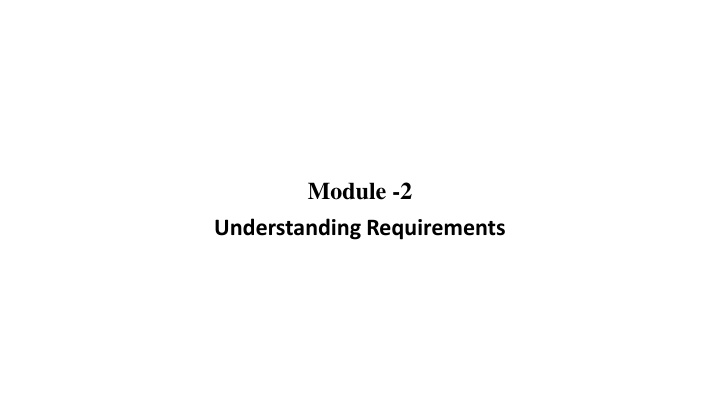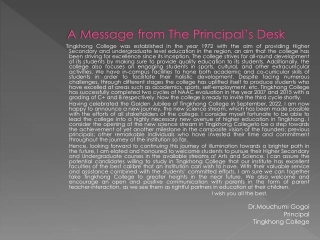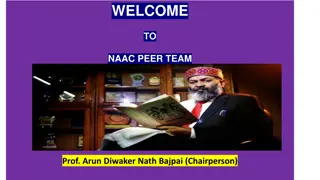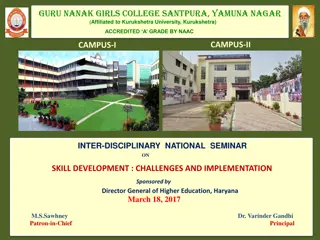
Understanding Requirements Engineering in Software Development
"Learn about the process of Requirements Engineering (RE) in software development, including tasks like Inception, Elicitation, Elaboration, Negotiation, Specification, and Requirements Management. Understand the challenges and solutions involved in collecting, analyzing, and documenting software requirements from clients to ensure successful project outcomes."
Download Presentation

Please find below an Image/Link to download the presentation.
The content on the website is provided AS IS for your information and personal use only. It may not be sold, licensed, or shared on other websites without obtaining consent from the author. If you encounter any issues during the download, it is possible that the publisher has removed the file from their server.
You are allowed to download the files provided on this website for personal or commercial use, subject to the condition that they are used lawfully. All files are the property of their respective owners.
The content on the website is provided AS IS for your information and personal use only. It may not be sold, licensed, or shared on other websites without obtaining consent from the author.
E N D
Presentation Transcript
Module -2 Understanding Requirements
Requirements Engineering The process of collecting the S/w req from the client and understanding,analysis and documenting it is called RE. RE constructs a bridge to design and construction. 7 different tasks. Inception Elicitation Elaboration Negotiation Specification Validation Requirements Management
Inception Inception Re asks set of questions to establish a s/w process Basic details,Aim,goal of the project and find out the solution. Identify stakeholders and who want the solution. Understand nature of the solution Collaboration b/w customer and developer. Elicitation Gathering the req from the stakeholders. Right people must be involved in this phase.(no space for mistake) The following problems may occur in this phase. Problem of scope un necessary technical details, rather than clarify of the overall system objective. leads to confuse.
Problem of understanding:the customers/users are not completely sure of what is needed. Poor understanding between developer and customer. Problem of volatility: the requirements change over time. Due to this we may face loss of money, time waste. Elaboration: It takes the req that have been gathered from 1&2 phases and expand them. The main task is developing model and prototype of software using functions,feature and using different tools. Negotiation: Negotiation b/w the developer and customer about limited availability of resources, delivery time, project cost and overall estimation of project. Prioritize the req for developer and also analyse any conflict has occur.
Specification: Constructs a final work product. form SRS Collect all the user system functional and no functional req. ER,DFD SRS will be submitted to the customer Any language Validation: Checking errors, debugging the final work product or srs. Checks all req Checks any mis information or want to add any additional information.
Requirements Management: RE is a set of activities that helps the project team To identify,control and track req and changes to the req at anytime as the project proceeds. Based on this phase the working model will be analyzed carefully and ready to be delivered to the customer.
Establishing the ground work Tools in RE Observation report Questionnaire (survey,poll) Use cases User stories Requirement workshop Mind mapping Role playing Prototyping
Identifying Stakeholders Any person who benefits directly or indirectly from the system being developed is a stakeholder. Ex:- Business operations managers,product managers,marketing people,internal and external customers,end-users,product engineers,software engineer,developer,tester, and support/maintainance engineers are the usual stakeholders. Each stakeholder sees the system differently,when the system is developed successfully. They also faces different risks if the development effort fails.
Recognizing multiple viewpoints Many different stakeholders the system requirements will be examined from various perspective. Each of the stakeholder will contribute the data. As the information is gathered from multiple viewpoints,collecting requirements may be inconsistent. Categories all the stakeholder information so that decision making can select an consistent set of requirements for the system.
Working toward collaboration If there are six stakeholders involved in a software project,there may be six different opinions on the requirements. Customers must work together with software development team to create a successful system. Requirement engineer s job is to identify areas of commonality as well as areas of conflict requirements. At the end project head and requirement engineer may decide which req are accepted .
Asking the first questions Focuses on the customers, stakeholders as well as the overall project goals and benefits. Who is behind the request for this work? Who will use the solution? What will be the economic benefit of a successful solution? Is there another source for the solution that you need? The next set of questions enables you to gain a better understanding of the problem. How would you characterize good output that would be generated by a successful solution? What problem(s) will this solution address? Can you show me (or describe) the business environment in which the solution will be used? Will special performance issues or constraints affect the way the solution is approached?
The final set of questions focuses on the effectiveness of the communication activity Are you the right person to answer these questions? Are your answers official ? Are my questions relevant to the problem that you have? Am I asking too many questions? Can anyone else provide additional information? Should I be asking you anything else?
Eliciting the requirements Requirements elicitation (also called requirements gathering) combines elements of problem solving, elaboration, negotiation, and specification. to encourage a collaborative, team-oriented approach to requirements gathering, stakeholders work together to identify the problem, propose elements of the solution, negotiate different approaches. Collaborative Requirements Gathering basic guidelines: Meetings are conducted Rules for preparation and participation are established. An agenda is suggested that is formal enough to cover all important points but informal enough to encourage the free flow of ideas. A facilitator (can be a customer, a developer, or an outsider) controls the meeting. A definition mechanism (can be work sheets, flip charts, or wall stickers or an electronic bulletin board, chat room, or virtual forum) is used
Quality Function Deployment Quality function deployment (QFD) is a quality management technique that translates the needs of the customer into technical requirements for software. QFD concentrates on maximizing customer satisfaction from the software engineering process . QFD identifies three types of requirements Normal requirements. Expected requirements. Exciting requirements.
Usage Scenarios Developers and users can create a set of scenarios that identify a thread of usage for the system to be con structed. The scenarios, often called usecases, provide a description of how the system will be used.
Elicitation Work Products requirements elicitation will vary depending on the size of the system or product to be built. A statement of need and feasibility. A bounded statement of scope for the system or product. A list of customers, users, and other stakeholders who participated in requirements elicitation. A description of the system s technical environment. A list of requirements (preferably organized by function) and the domain constraints that apply to each. A set of usage scenarios that provide insight into the use of the system or product under different operating conditions. Any prototypes developed to better define requirements. Each of these work products is reviewed by all people who have participated in re quirements elicitation
Developing use cases The first step in writing a use case is to define the set of actors . Once actors have been identified, use cases can be developed. Who is the primary actor, the secondary actor(s)? What are the actor s goals? What preconditions should exist before the story begins? What main tasks or functions are performed by the actor? What exceptions might be considered as the story is described? What variations in the actor s interaction are possible? What system information will the actor acquire, produce, or change? Will the actor have to inform the system about changes in the external environment? What information does the actor desire from the system? Does the actor wish to be informed about unexpected changes
Requirement analysis It is significant and essential activity after elicitation. Reviews all req and provide graphical view of entire system. After all the analysis understanding of the project many improve significantly.
Building the requirements model Elements of the Requirements Model 1.Scenario-based elements. 2.Class-based elements. 3.Behavioral elements. 4.Flow-oriented elements. Analysis Patterns Analysis patterns suggest solutions (e.g., a class, a function, a behavior) within the application domain that can be reused when modeling many applications. speed up the development of abstract analysis models that capture the main requirements of the concrete problem by providing reusable analysis models. facilitate the transformation of the analysis model into a design model by suggesting design patterns and reliable solutions for common problems.
Scenario-based elements. For building the design and analysis model,it is important for SE to understand how end users and others actors want to interact with the system. Scenario-based elements of the requirements model are often the first part of the model that is developed Scenario by using use case diagram,activity diagram and user stories. workflow conditions Virtual representation of how users interact with a system.or dynamic behaviour of a system.
Class-based elements. set of objects that are manipulated as anactor interacts with the system.These objects are categorized into classes A collection of things that have similar attributes and common behaviors. Sensor class for the Safe Home security function. Ex:- the attributes of sensors(e.g., name, type) and the operations (e.g., identify, enable) classes collaborate with one another and the relationships andinteractions between classes.
Flow-oriented elements Flow of data ----------------DFD Information is transformed as it flows through a computer-based system. The system accepts input in a variety of forms, applies functions to transform it, and produces output in a variety of forms. Input may be a control signal transmitted by a transducer, a series of numbers typed by a human operator,
Behavioral elements The state diagram is one method for representing the behavior of a system by depicting its states and the events that cause the system to change state. To represent in the form of picture or story. observable mode of behavior.
Behavioural elements UML activity diagrams for eliciting requirements
Behavioral elements class diagram of sensor
Negotiating requirements The intent of this negotiation is to develop a project plan that meets stakeholder needs . while at the same time reflecting the real-world constraints (e.g., time, people, budget) that have been placed on the software team. The best negotiations strive for a win-win result. Boehm [Boe98] defines a set of negotiation activities at the beginning of each soft ware process iteration. Rather than a single customer communication activity, the following activities are defined: 1. Identification of the system or subsystem s key stakeholders. 2. Determination of the stakeholders win conditions. 3. Negotiation of the stakeholders win conditions to reconcile them into a set of win-win conditions for all concerned (including the software team). Successful completion of these initial steps achieves a win-win result,
Validating requirements Customer what really wants. All functions should be checked.-------completeness Realstic -----within the budject. All requirements should be implemented and it has to be checked.(error free) Requirements reiews should be done when your are going to add new reqmnts. Prototyping for each and every requirements. In review both customer and team lead or developer should be present. Formal or informal meetings. Properly understand the requirement------purpose of req Treasability----origin of the requirement---------from where this req arise. Req are dependents from one to another.---------relationship
Requirements Analysis RA results specification of s/w operational characteristics ----indicates s/w interface with other system elements, Also establishes constraints that s/w must meet. It also allows to elaborate on basic req during elicitation,inception,negotiation tasks. The basic req modelling action results 1 or more types. Scenario-based models ,data models,class-oriented models ,flow oriented models and behavioral models. a technique that is growing increasingly popular throughout the software engineering community Users to share ideas, progress software projects, support each other.
data modelinga more specialized technique that is particularly appropriate when an application must create or manipulate a complex information. Class modeling a representation of the object-oriented classes and the resultant collaborations.
Overall Objectives and Philosophy focus is on what, not how. What user interaction occurs in a particular circumstance, what objects does the system manipulate, what functions must the system perform, what behaviors does the system exhibit, what interfaces are defined, and what constraints apply
The requirements model must achieve three primary objectives: (1) to describe what the customer requires, (2) to establish a basis for the creation of a software de sign, (3) to define a set of requirements that can be validated once the software is built.
The analysis model bridges the gap between a system-level description that describes overall system or business functionality as it is achieved by applying soft ware, hardware, data, human, and other system elements and a software design that describes the software s application architecture, user interface, and component-level structure.
requirements model will be directly traceable to parts of the design model. Analysis Rules of Thumb when creating the analysis model The model should focus on requirements that are visible within the problem or business domain. Each element of the requirements model should add to an overall understanding of software requirements , and behavior of the system. Delay consideration of infrastructure and other nonfunctional models until design. It is important to represent relation ships between classes and functions. designers should use the model as a basis for design; QA people should use the model to help plan acceptance tests. Keep the model as simple as it can be
Domain Analysis Fig: Illustrates key inputs and outputs for the domain analysis process. Sources of domain knowledge are surveyed in an attempt to identify objects that can be reused across the domain
The specific application domain can range from banking, from multi media video games to software embedded within medical devices. The goal of do main analysis is straightforward: to find or create those analysis classes and/or analysis patterns that are broadly applicable so that they may be reused. Domain analysis may be viewed as an umbrella activity for the software process. mean that do main analysis is an ongoing software engineering activity that is not connected to any one software project. In a way, the role of a domain analyst is similar to the role of a master tool smith in a heavy manufacturing environment. The job of the tool smith is to design and build tools that may be used by many people doing similar but not necessarily the same jobs. The role of the domain analyst is to discover and de fine analysis patterns, analysis classes, and related information that may be used by many people working on similar but not necessarily the same applications.
requirements modeling, called structured analysis, considers data and the processes that transform the data as separate entities. Data objects are modeled in a way that defines their attributes and relationships. Processes that manipulate data objects are modeled in a manner that shows how they transform data as data objects flow through the system. A second approach to analysis modeling, called object-oriented analysis, focuses on the definition of classes and the manner in which they collaborate with one an other to effect customer requirements. Scenario-based elements depict how the user interacts with the system and the specific sequence of activities . Class-based elements model the objects that the system will manipulate, the opera tions. Behavioral elements depict how external events change the state of the system. Finally, flow-oriented ele ments represent the system as an information transform, depicting how data objects are transformed as they flow through various system functions.
WEBLINK https://www.youtube.com/watch?v=cNG4KuoyfiI&list=PLbRMhDVU Mngf8oZR3DpKMvYhZKga90JVt&index=5


















